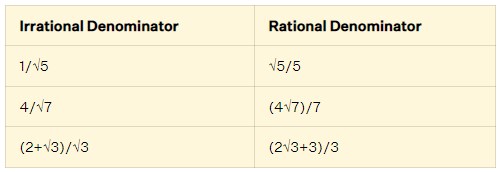‘Rationalize the denominator calculator’ is a free online tool. The Rationalize the denominator calculator gives a denominator in a simple form for a given input. An online ‘rationalize the denominator calculator’ makes the calculation faster. It gives accurate results within a few seconds.
Rationalize the Denominator Calculator Step by Step
The steps to rationalize the Denominator Calculator are as follows.
- First, enter the value of the numerator and the denominator in the input field.
- Click the button “Rationalize Denominator” to get the output.
- Step 3- Finally, the result is shown in the output field.
We use Rationalize the Denominator calculator in this way.
Rationalize the Denominator Calculator Wolfram is one such tool.

Rationalizing the Denominator Step by Step explanation
Rationalizing the denominator is eliminating any radical expressions in the bottom fraction. For example, square roots and cube roots, etc. The main idea is to multiply the original fraction by a correct value. The bottom fraction does not contain radicals after the simplification.
Read Also:Parabola Calculator- parabola equation, meaning, formula
Rationalization can be said as the method that is used to cancel a radical or an imaginary number from the bottom fraction of an algebraic fraction as well. It means to remove the radicals in a fraction. The bottom fraction only contains a rational number after that. To explain let us now recall some major terms relating to the concept of rationalization.
Radical
A radical is an expression that uses a root. For example, a square root, cube root, etc. A radical expression looks like this: √ (a + b). This is radical.
A radical equation is an equation that is inside a radical. A radical expression is an expression that lies inside a square root. Radical inequality is a statement that two things are not equal, that is inside a radical.
The radicals must have the same index number to multiply or divide two radicals. The product rule says that the multiplication of two radicals simply multiplies the values within. It places the answer within the same kind of radical. Then if possible, simplify it.
Radicand
Radicand is an expression that is written inside a root symbol. It can be any number or variable. We are finding the root and it is the size. The term ‘radicand’ is used while learning about exponents and roots. The image given below has (a + b) as the radicand.

Radical Symbol
The √ symbol speaks for the “root of”. The length of the horizontal bar is important here. The length of the bar suggests variables or constants that are a part of the root function. The variables or constants are not a part of the root when they are not under the root symbol (√). A radical symbol represents taking the square root of an expression. It is also used to represent taking the nth root of a number. It is when a number ‘n’ is placed above the start of the symbol.

Degree
The degree of a polynomial is the highest exponential power in a polynomial equation. The variables are only look at to check for the degree of a polynomial. Coefficients are avoided. The degree of a polynomial is the greatest power of a variable in a polynomial equation. The terms with variables are used for finding the degree of the polynomial to decide the degree of the function only.
Here, 2 represents square root, 3 represents cube root (like shown in the image below). Similarly, they are referred to as 4th root, 5th root, and so on. Whenever this is not said, we take it as square root without fail.

Conjugate
Conjugate means a pair of things that are joined together. The math conjugate of any binomial means another exact binomial with the opposite sign between its two terms. The conjugate is where you change the sign (+ to −, or − to +) in the middle of two terms.
For instance, the conjugate of (a + b) is (a – b) or vice versa. Therefore, both these binomials are conjugates of each other.
Rationalizing a Surd
Surds are any real number that cannot be expressed as the quotient of two integers. Surds are irrational numbers. A surd is an expression that includes a square root, cube root or any other root symbol. The decimals of irrational numbers do not end. To explain, this is because they cannot be written exactly in decimal form. It cannot be any simpler in its radical form. To emphasize, an irrational number √8 can be simplified as 2√2. Whereas √2 cannot be made simpler anymore. In conclusion, √2 is a surd.
A monomial or simple surd is a surd having a single term only. For example: √6, 3√2, ∛2.
Binominal surds or compound surds are the algebraic sum of two or more simple surds or the algebraic sum of rational numbers and simple surds. For example: √3 + √6, 1 – √2.
The step for moving the root from the bottom of a fraction to the top of an expression depends on the radical. In short, if the expression that is monomial or binomial.
Rationalizing a Monomial Radical
Rationalizing a surd or radical (in the denominator) depends upon the degree of the polynomial. It also depends on the fact that if the radical is a monomial or polynomial. Then we follow other steps. A monomial is a polynomial with only one term. For instance,, , etc. could be in the bottom fraction.
Let us understand it step by step using the following examples.
Example- Let us rationalize the fraction: .
Step 1- Firstly, check out the fraction. The given fraction has in the denominator. We will move the root from the bottom of a fraction to the top. It is not needed to worry about the top fraction while checking the fraction or simplifying it.

Step 2- Next, multiply the fraction in the top and bottom fraction by .
Step 3- To conclude, simplify the expression as needed.
=.
Rationalizing a Binomial Radical
Let us think the bottom fraction has a radical expression of the form a+√b or a+i√b. The fraction is multiplied by (a-√b) or (a-i√b), both in the top and bottom fraction.
Procedure; Here, we will think the bottom fraction has a radical expression. (a+√b) or (a+i√b). The radical is multiplied by its conjugate here.
Example: Let us now, have a look at the following fraction, .
We will move the root from the bottom of a fraction to the top.
x .
It is simplified and evaluated as 5(2+) some more.
Suitable algebraic identities are used in expanding the bottom fraction here.
Let us learn the process to do the following fraction:.
Step 1- Firstly, check out the fraction. The bottom fraction of the above fraction has a binomial radical. It is the sum of two terms. There is one irrational number here.
Step 2- In addiction, we will multiply the top fraction and bottom fraction. Furthermore, we will multiply it with the conjugate of the radical.
x
By using difference of squares algebraic property [(a+b)(a-b)=-]
x
=
=
=.
Rationalize the Denominator Calculator Cube Root
The method generalized to the roots of any order while moving the root from the bottom of a fraction to the top is told here. We can follow the steps given below for the given fraction with cube root radical in the bottom fraction, .
Step 1- In the first place, check out the fraction. The fraction has a radical in the form of a cube root in the bottom fraction.
Step 2- Next, multiply the top fraction and bottom fraction by a factor that makes the exponent of the bottom fraction 1. In this case, that factor would be .
Step3: Finally, simplify the expression as required.
x
=
=
=.
Rationalize the Denominator Calculator Explanation
Answer: It will become clearer when you look at the definition of “rationalize”, about what exactly rationalizing a denominator means. The numbers , 5 and 0.25are all rational numbers. These can be expressed as a ratio of two integers such as, , , respectively. There are some radicals which are irrational numbers which cannot be represented as the ratio of two integers. Therefore, the bottom fraction of the expression needs to be rationalized so that the expression becomes a rational number. The equivalent rational values of an irrational number is shown in the table below .

This table lists the irrational denominators and their rational equivalents.
The steps to move the root from the bottom fraction to the top the in a fraction are as follows.
Step 1- Firstly; multiply the bottom fraction and top fraction by a correct radical. This will remove the radicals in the bottom fraction.
Step 2- Secondly, you have to make sure all surds in the fraction are in simplified form.
Step 3- Lastly, you can simplify the fraction more if needed.
Therefore, the fraction is in its simplest form. The bottom fraction becomes rational.
Rationalize the Denominator Calculator Using Conjugates.
Answer: Let us understand what conjugates are before we learn how to rationalize a bottom fraction. A math conjugate forms when the signs between two terms in a binomial changes. For example, the conjugate of x+y is x-y. So, (x+y) is a conjugate of (x-y).
Likewise, the conjugate of (√7-2) is (√7+2).
Rationalize the denominator Calculator: Using Algebraic Identities.
Answer: One more way to rationalize the bottom fraction is to use algebraic identities. The algebraic formula used in the process of rationalization is
(-)= (a+b)(a-b).
- In order to rationalize (+), the rationalizing factor is (-).
- In order to rationalize (-), the rationalizing factor is (+).
- (+) x (-)
=-
= a-b.
Let us use an example to understand this better.
Rationalize the Denominator Calculator With 3 Terms.
Answer: We can proceed with the same steps we used to rationalize the bottom fraction with two terms. That, but with a couple of changes. Let us take a bottom fraction with three terms: a + b + c. Earlier we have moved the root from the bottom of a fraction to the top, when the bottom fraction had 2 terms: (a + b) by multiplying with its conjugate (a – b). Similarly, we can move the root from the bottom of a fraction to the top when the bottom fraction that contains three terms by grouping them as, (a + b + c) = (a + b) + c. By using the difference of squares formula, we get.
[(a + b) + c]x[(a + b) – c]=-
Some Important Points to Remember:
We should remember the following points while studying rationalization:
- Rationalization means to remove a radical or an imaginary number from the top fraction of any given algebraic fraction. In simple words, remove the radicals in a fraction so that the bottom fraction only contains a rational number.
- A radical is an expression that uses a root, like the square root or cube root. For instance, an expression of the form: √ (a + b) is radical.
- Math conjugates of binomials present another same binomial with the opposite sign between its two terms.
Rationalize the Denominator Calculator with steps and Simplify (with solution).
Illustration – Rationalize the denominator in the given fraction:.
Answer: Here, for moving the root from the bottom of a fraction to the top, we need another √7.
= x
=
=.
As a result, the answer is .
Illustration 2- Rationalize the denominator in the given fraction: .
Answer: The factor to rationalize () is (). Therefore, let us multiply both the numerator and the denominator with ().
=
=
=
As a result, the answer is).
FAQs (Frequently Asked Questions).
- How do you rationalize the Denominator and simplify it?
- First of all, multiply both the bottom and top fraction with a correct conjugate. This will remove the radicals from the denominator.
Furthermore, we need to make sure that all the surds in the given fraction are in their simplified form.
- Simplify the fraction more if needed.
- What does rationalize the Denominator Mean?
Rationalizing the denominator means the process of moving a root. For example, a cube root or a square root from the bottom of a fraction to the top of the fraction. Accordingly, we bring the fraction to its simplest form thereby, the bottom fraction is rational.
- Can root 12 be a pure surd?
Pure surds have no rational factor except unity. For instance, 2√2, 2√5,2√7, 2, 3√15, 5√30, 7√50, n√x all are pure surds. Since these have rational numbers only under the radical sign. Or the whole expression purely belongs to a surd.
- Can Surds have decimals?
A surd is an expression that has a square root, cube root, or another root symbol. As the decimals of irrational numbers do not cut off we cannot write it exactly in decimal form.
- How do you rationalize a Denominator with 2 Terms?
The steps to move the root from the bottom of a fraction, having 2 terms to the top are as follows:
Step 1- First; multiply the top and bottom of the fraction with the conjugate of the top fraction. We do it to move the root from the bottom of a fraction to the top.
Step 2- Next, change the sign between the two terms. Find the conjugate of the two terms.
Step 3-This time mix all the like terms. Finally, simplify the radicals.
Step 4- If possible; try to cut down the fraction to its simplest form.




